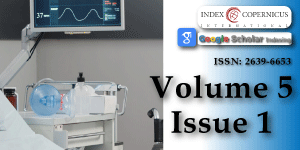Case reports of observed significant improvement in patients with ARDS due to COVID-19 and maximum ventilatory support after inhalation of sodium bicarbonate
Main Article Content
Article Details
Copyright (c) 2020 Wardeh A, et al.

This work is licensed under a Creative Commons Attribution 4.0 International License.
Chu, V. McElroy, L. Chu, V. Bauman, B. Whittaker, G. The Avian Coronavirus Infectious Bronchitis undergoes direct low PH dependent Fusion activation during entry into the host cells. J Virol. 2006; 80: 3180-3188. PubMed: https://www.ncbi.nlm.nih.gov/pubmed/16537586
Yong ZY, Huang Y, Ganesh L, Leung K, Kong wp. et al. pH-Dependent Entry of Severe Acute Respiratory Syndrome Coronavirus Is Mediated by the Spike Glycoprotein and Enhanced by Dendritic Cell Transfer through DC-SIGN. J Virol. 2004; 78: 5642-5650. PubMed: https://www.ncbi.nlm.nih.gov/pmc/articles/PMC415834/
McShane D, Davies JC, Davies MG, Bush A, Geddes DM, et al. Airway surface PH in subjects with cystic fibrosis. Eur Respir J. 2003; 21: 37-42. PubMed: https://www.ncbi.nlm.nih.gov/pubmed/12570106
Gomez CCS, Parazzi PLF, Clinckspoor KJ, Mauch RM, Pessine FBT, et al, safety, tolerability and effectes of sodium bicarbonate inhalation in cystic fibrosis. Clin Drug Investig. 2019; 40: 105-117. PubMed: https://www.ncbi.nlm.nih.gov/pubmed/31721070
Aslan S, Kandiş H, Akgun M, Cakir Z, Inandi T, et al. The effect of nebulized sodium bicarbonate treatment on RADS patients due to chlorine gas inhalation. Inhal. Tox. 2006; 18: 895-900. PubMed. https://www.ncbi.nlm.nih.gov/pubmed/16864407
NIH NHLBI ARDS clinical network, mechanical ventilation protocol summary, 2017.
Kis A. Toth L, Kunos L, Gyorgy L, Wanner A. The effect of airway alkalinization by nebulized sodium bicarbonate on airway blood flow. European Res. Journal. 2012; 40: P2143.
Chinese SARS Molecular Consortium. Science 10.1126/science.1092002.
Bosch BJ, Martina BE, Van Der Zee R, Lepault J, Haijema BJ, et al. Severe ARDS due to SARS CoV infection inhibition using spike protein heptad repeated-derived peptides. Proc Natl Acad Sci USA. 2004; 101: 8455-8460. PubMed: https://www.ncbi.nlm.nih.gov/pubmed/15150417

